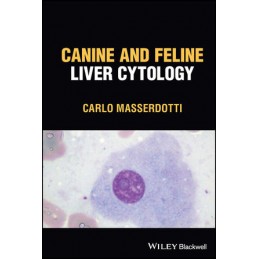- Reduced price

Order to parcel locker

easy pay


 Delivery policy
Delivery policy
Choose Paczkomat Inpost, Orlen Paczka, DHL, DPD or Poczta Polska. Click for more details
 Security policy
Security policy
Pay with a quick bank transfer, payment card or cash on delivery. Click for more details
 Return policy
Return policy
If you are a consumer, you can return the goods within 14 days. Click for more details
Specialist reference with practical guidance on liver pathology in a clinical and anatomical context
Canine and Feline Liver Cytology is a practical and highly illustrated manual with detailed descriptions of cytological features of hepatic diseases and numerous high-quality illustrations to aid in reader comprehension. The primary aim of the text is to describe the correlation of cytological findings with pathological processes in order to provide useful information to clinicians in management of hepatic diseases.
Canine and Feline Liver Cytology includes information on::
Canine and Feline Liver Cytology enables readers to interpret all the cytopathological changes in liver pathology and the relationship with clinical primary and secondary causes, eventually with histopathological diagnosis, making it a highly valuable resource for veterinary practitioners and students.
Data sheet
About the Author ix
Foreword xi
Preface xiii
Acknowledgments xv
1 Before the Analysis: Rules for Interpretation of Hepatic Cytology 1
1.1 The Rules for Cytological Diagnosis of Hepatic Diseases 2
1.1.1 Rule 1 2
1.1.2 Rule 2 2
1.1.3 Rule 3 2
1.1.4 Rule 4 3
1.1.5 Rule 5 3
1.1.6 Rule 6 3
1.1.7 Rule 7 4
1.1.8 Rule 8 4
1.2 Diagnostic Approach to Liver Disease 4
1.2.1 Clinical and Anamnestic Signs 5
1.2.2 Hematochemical Investigation 5
1.2.2.1 Pathological Bases of Liver Damage 5
1.2.2.2 Diagnosis of Liver Damage 8
1.2.2.3 Useful Enzymes for Recognition of Damage to Hepatocytes and Cholangiocytes 9
1.2.2.4 Liver Failure Diagnosis 11
1.2.2.5 Parameters of Liver Failure 12
1.2.3 Ultrasonographic Investigation 14
1.2.4 Cytological and Histopathological Investigation 15
1.2.4.1 Sample Collection 15
1.2.4.2 Cytological Approach to Hepatic Diseases 16
1.3 Key Points 16
References 17
2 Normal Histology and Cytology of the Liver 19
2.1 Normal Histology of the Liver 19
2.2 Normal Cytology of the Liver 27
2.2.1 Hepatocytes 28
2.2.2 Kupffer Cells 30
2.2.3 Stellate Cells (Ito Cells) 31
2.2.4 Cholangiocytes (Biliary Cells) 32
2.2.5 Hepatic Lymphocytes 33
2.2.6 Hepatic Mast Cells 34
2.2.7 Hematopoietic Cells 34
2.2.8 Mesothelial Cells 36
2.3 Key Points 38
References 39
3 Nonspecific and Reversible Hepatocellular Damage 41
3.1 Accumulation of Water 42
3.2 Accumulation of Glycogen 43
3.3 Accumulation of Lipids 46
3.4 Accumulation of Bilirubin and Bile Salts 57
3.5 Hyperplasia of Stellate Cells 57
3.6 Regenerative Changes 59
3.7 Key Points 64
References 64
4 Intracytoplasmic and Extracytoplasmic Pathological Accumulation 67
4.1 Pathological Intracytoplasmic Accumulation 67
4.1.1 Lipofuscin 67
4.1.2 Copper 73
4.1.3 Iron and Hemosiderin 76
4.1.4 Protein Droplets 82
4.1.5 Cytoplasmic Granular Eosinophilic Material 82
4.1.6 Hepatic Lysosomal Storage Disorders 85
4.2 Pathological Extracytoplasmic Accumulation 86
4.2.1 Bile 86
4.2.2 Amyloid 90
4.3 Key Points 96
References 96
5 Irreversible Hepatocellular Damage 101
5.1 Necrosis 101
5.2 Apoptosis 107
5.3 Key Points 110
References 110
6 Inflammation 113
6.1 Presence of Neutrophilic Granulocytes 115
6.2 Presence of Eosinophilic Granulocytes 123
6.3 Presence of Lymphocytes and Plasma Cells 125
6.4 Presence of Macrophages 130
6.5 Presence of Mast Cells 137
6.6 Key Points 139
References 139
7 Nuclear Inclusions 143
7.1 “Brick” Inclusions 143
7.2 Glycogen Pseudo-inclusions 144
7.3 Lead Inclusions 146
7.4 Viral Inclusions 146
7.5 Key Points 147
References 147
8 Cytological Features of Liver Fibrosis 149
8.1 Cytological Features of Liver Fibrosis 150
8.2 Key Points 159
References 160
9 Cytological Features of Biliary Diseases 163
9.1 General Features of Biliary Diseases 165
9.2 Cytological Features of Specific Biliary Diseases 167
9.2.1 Acute and Chronic Cholestasis 167
9.2.2 Acute Cholangitis 170
9.2.3 Chronic Cholangitis 170
9.2.4 Lymphocytic Cholangitis 170
9.3 Key Points 175
References 175
10 Bile and Gallbladder Diseases 177
10.1 Bactibilia and Septic Cholecystitis 179
10.2 Epithelial Hyperplasia 181
10.3 Gallbladder Mucocele 181
10.4 Limy Bile Syndrome 183
10.5 Biliary Sludge 183
10.6 Neoplastic Diseases of Gallbladder 183
10.7 Other Gallbladder Diseases 184
10.8 Key Points 184
References 184
11 Etiological Agents 187
11.1 Viruses 188
11.2 Bacteria 189
11.3 Protozoa 193
11.4 Fungi 194
11.5 Parasites 194
11.6 Key Points 197
References 197
12 Neoplastic Lesions of the Hepatic Parenchyma 199
12.1 Epithelial Neoplasia 200
12.1.1 Nodular Hyperplasia 200
12.1.2 Hepatocellular Adenoma 204
12.1.3 Hepatocellular Carcinoma 206
12.1.4 Cholangioma 215
12.1.5 Cholangiocellular Carcinoma 217
12.1.6 Other Nodular Lesions of Biliary Origin 222
12.1.7 Hepatic Carcinoid 223
12.1.8 Hepatoblastoma 227
12.2 Mesenchymal Neoplasia 227
12.2.1 Malignant Mesenchymal Neoplasms 227
12.3 Hematopoietic Neoplasia 229
12.3.1 Myelolipoma 231
12.3.2 Large Cell Hepatic Lymphoma 232
12.3.3 Small Cell Lymphoma 234
12.3.4 Large Granular Lymphocyte (LGL) Lymphoma 236
12.3.5 Epitheliotropic Lymphoma 239
12.3.6 Other Types of Hepatic Lymphoma 240
12.3.7 Malignant Histiocytic Neoplasms 242
12.3.8 Mast Cell Tumor 245
12.3.9 Hepatic Splenosis 247
12.4 Metastatic Neoplasia 247
12.5 Criteria for Selection of Sampling Methods for Liver Nodular Lesions 248
12.6 Key Points 250
References 250
Index 255
